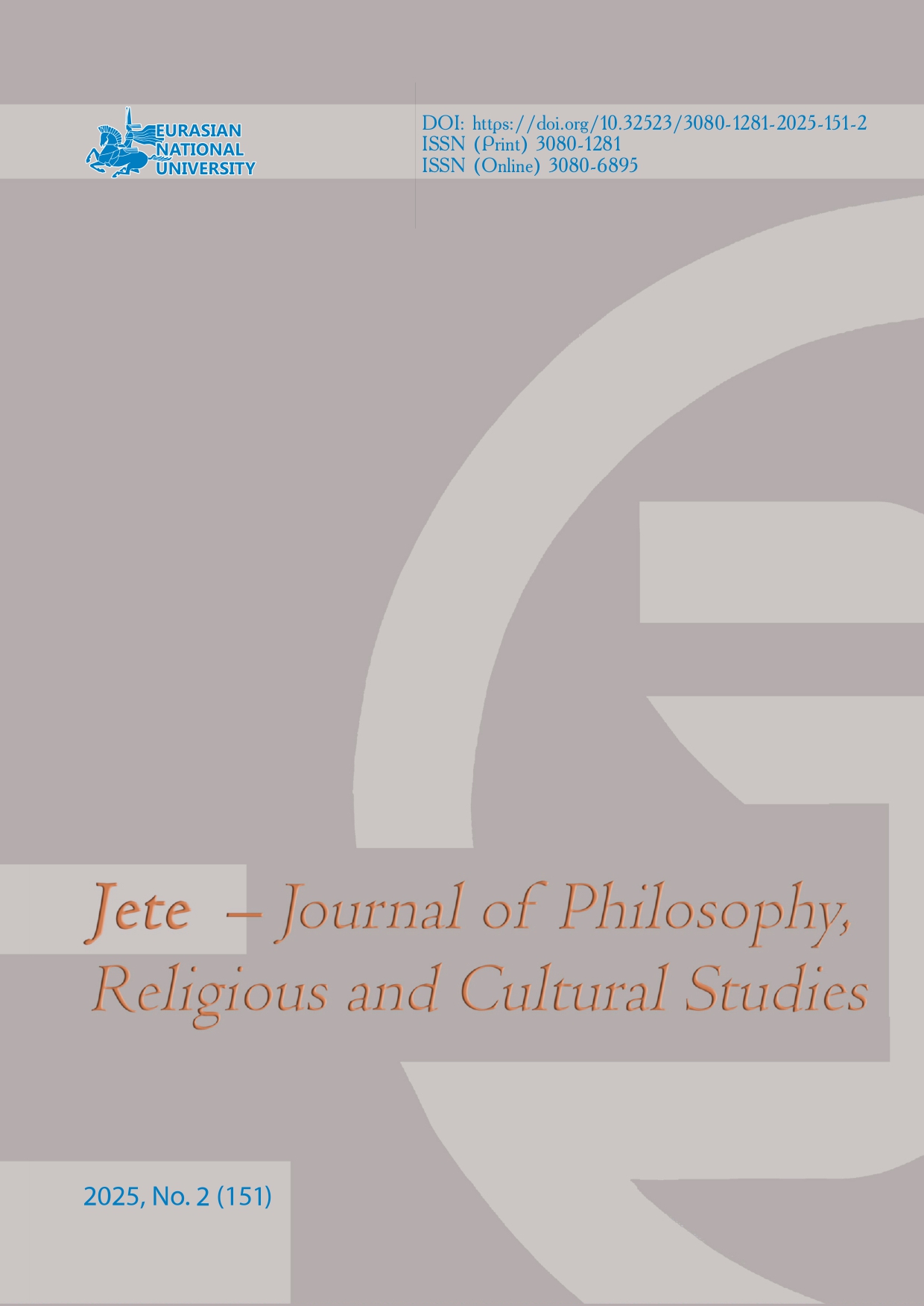The The Nature and Significance of the Problem of Husn (Goodness) and Qubh (Evil) in Imam Maturidi’s Thought
Scientific article
Views: 201 / PDF downloads: 68DOI:
https://doi.org/10.32523/3080-1281-2025-151-2-75-95Keywords:
Maturidi, husn, qubh, faith, reason, wisdom, justice, ethics, destiny, theologyAbstract
The theological interpretations and teachings of Imam Maturidi play crucial role in the systematic formulation of the foundations of faith. In his book "Tawilat Al-Quran" and "Kitab al-Tawhid", the eminent scholar provides a comprehensive analysis of fundamental concepts essential for Islamic thought, including discussions on knowledge and wisdom, the oneness of God, the afterlife and the principles of husn and qubh (goodness and evil). The article explores the methodological foundations of the concepts of husn and qubh in the theological doctrine of Imam Maturidi, assessing their role and significance within Islamic philosophical thought. Additionally, it examines the theological basis of these concepts and their integration into the ethical value system of Islam. The study also elucidates the correlation between reason and revelation a fundamental principle of Maturidi’s creed through the lens of this conceptual framework. In this context, the article discusses the linguistic and scientific definitions of husn and qubh, their religious and philosophical features, their recognition through reason and their discussion among different theological schools. Additionally, the role of this concept in the formation and development of ethical notions within the Islamic worldview is analyzed. Imam Maturidi’s views are analyzed in comparison with the Ash’ari and Mu’tazilah schools, highlighting both their commonalities and differences. Additionally, the understanding of husn and qubh is the Kazakh worldview is explored through the perspectives of Abai, Shskarim and Mashur Zhusip.
Downloads
References
Akimkhanov, A. B., Frolov, A. A., Adilbaeyva, S. A., & Yerzhan, K. (2016). Principles of Abu Mansur al-Maturidi, Central Asian Islamic theologian preoccupied with the question of the relation between the iman/credo and the action in Islam. European Journal of Science and Theology, 12(6), 165–176.
Çelebi, İlyas. (1998-1999). Klasik Bir Kelâm Problemi: Hüsün-Kubuh [A Classical Kalām Problem: Husn and Qubh]. Marmara Üniversitesi İlahiyat Fakültesi Dergisi. Sayı:16-17, - s. 55-90.
Çelebi, İlyas. (1999). “Hüsün ve Kubuh” [Good and Evil]. İslam Ansiklopedisi. c. 19, - ss. 59-63.
Ekiz, Recep. (2010). İmam Mâturîdî’ye göre Hüsün ve Kubuh [Husn and Qubh According to Imam al-Māturīdī]. Basılmamış Yüksek Lisans Tezi. – Sivas: Cumhuriyet Üniversitesi SBE. – s. 146.
Erdoğan, Mehmet. (2005). Fıkıh ve Hukuk Terimleri Sözlüğü [Dictionary of Fiqh and Legal Terms]. – İstanbul: Ensar Neşriyat, 2005. – s. 450.
Güvenkaya, İkra. (2021). Ebü’l-Muîn en-Nesefî’nin Hüsün-Kubuh Anlayışı [Abū al-Mu‘īn al-Nasafī’s Understanding of Husn and Qubh]. Basılmamış Yüksek Lisans Tezi. – Kırıkkale: Kırıkkale Üniversitesi SBE. – s. 136.
İbn Manzur Abu’l-Fadl Cemaluddin Muhammed İbn Mukerrem. (1990) Lisanu’l Arab, “hsn”, “kbh” [Arabic Language Dictionary “ḥ-s-n” and “q-b-ḥ”], Beirut, IV, s. 980.
İbnu’l-Jauzi. (1984). Nuzhetu’l-A’yun [The Delight of the Eyes]. nashr. M. Abduikarim Kazım er-Razi, Beirut, 1404/1984, - s. 590.
Jurjani, Sayyid Sharif. (1925). At-Tarifat [The Definitions]. nashr. İbrahim al- Abyari, Daru’l- Kutubu’l- Arabi, “hsn”, “kbh”, Beirut. – s. 1200.
Jurjani, Sayyid Sharif. (1938) Kitâbu’t-Tarifat [The Book of Definitions], Kahire. – s. 500.
Kazanç, Fethi Kerim. (2020). Ebü’l-Mu’în en-Nesefî’nin Kelâmî Düşünce Sisteminde İnsan Görüşü [The Concept of Human in Abū al-Muʿīn al-Nasafī’s Theological Thought System]. Ondokuz Mayıs Üniversitesi İlâhiyat Fakültesi Dergisi, Sayı: 48, (Haziran) 2020, ss. 51-95. https://doi.org/10.17120/omuifd.725680
Kenzhetayev D.T., Nurmatov Zh.Y., Myrzabekov M.M. (2024). The Features of Maturidi Doctrine and its Impact on Kazakh Culture. HIKMET. №1 (2). – Б. 5–18. https://doi.org/10.47526/3007-8598-2024.2-05
Razi, Fahreddin. (2002). Kelâm’a Giriş (el-Muhassal) [Introduction to Kalām (al-Muḥaṣṣal)]. çev. Hüseyin Atay, T.C. Kültür Bakanlığı Yayınları, Ankara, - s. 600.
Sabuni, Nûreddin. (2015) Mâtüridiyye Akâidi (el-Bidâye fi Usûlid-Dîn) [The Doctrine of the Māturīdiyya (al-Bidāya fī Uṣūl al-Dīn)]. çev. Bekir Topaloğlu, Marmara Üniversitesi İlahiyat Fakültesi Vakfı Yayınları, İstanbul, - s. 500.
Sami, Şemsettin. (1898). “s-v-e”, Kâmus-ı Türkî [“s-v-e” Turkish Dictionary], İkdam Matbaası, I. Cilt.- s. 900.
Yeprem, M. Saim. (1997). İrade Hürriyeti Ve İmam Mâturîdî [Freedom of Will and Imam al-Māturīdī]. İFAV, İstanbul. - s. 97.
Maturidi, Abu Mansur. (2020). Tawhid Kitaby [The Book of Divine Unity]. Nur-sultan: Muftyat baspasy. - 572 b.
Esim G. (2002). Hakim Abai [Sage Abai]. – Astana: Foliant. - 400 b.
Kenzhetayev D.T. (2007). Kozha Ahmet Yasawi Filosofiyasi jane turki dunietanymy tarihindagi orny [The Philosophy of Khoja Ahmed Yasawi and His Role in the History of Turkic Worldview]. Filos. gil.dok. gilimi darejesin alu ushin dayindalgan dissertatsiya. - Almaty. – 259 b.
Kopeiuly M. (2003). Kop tomdyk shigarmalar jinagi [Multi-Volume Collection of Works]. 1-tom. qurastirgan Zhusipov E. -Almaty: Alash. – 440 b.
Kunanbaev A. (1961). Shigarmalarinin bir tomdik jinagi [Single-Volume Collection of Works]. – Almaty: «Qazmemkoradbas». – 692 b.
Shakarim. (2000). Imanym [My Faith]. – Almaty: «Arys» baspasy, - 321 b.
Ybyrai S. (2021). Zharim adamnan tolik adamga [From a Half-Person to a Whole Human Being]. – Nur-Sultan: Alashorda. – 258 b.
Downloads
Published
Issue
Section
License
Copyright (c) 2025 Мұхит Төлегенов , Жахангир Нурматов , Турганбай Абдрасилов (Автор)

This work is licensed under a Creative Commons Attribution-NonCommercial-NoDerivatives 4.0 International License.













